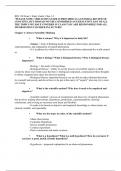BIO 110 Exam 1 Study Guide: Chps 1-5
*PLEASE NOTE: THIS STUDY GUIDE IS PROVIDED AS A GENERAL REVIEW OF CONCEPTS, BUT SHOULD NOT BE CONSIDERED AN EXHAUSTIVE LIST OF ALL THE TOPICS WE HA VE COVERED IN CLASS! YOU ARE RESPONSIBLE FOR ALL INFORMATION COVERED IN LECTURE!
Chapter 1: Intro to Scientific Thinking
•What is science? Why is it important to daily life?
- Science = body of thinking based on objective observation, description, experimentation, and explanation of natural phenomena
- It is a pathway by which we can discover and better understand the world around
us
•What is biology? What is biological literacy? Why is biological literacy
important?
- Biology = the study of living things
- Biological literacy = ability to use the process of scientific inquiry to think creatively about real world issues that have a biological component, communicate these thoughts
to others, integrate these ideas into decision making - Biological literacy important because you are able to make informed decisions for yourself and society and do not have to be put at the mercy of “experts” who may try to steer you wrong. •What is the scientific method? Why does it need to be empirical and objective?
- Scientific method = process of examination and discovery of natural phenomena that involves making observations, hypotheses, predictions, experimentations, drawing conclusions, and revising as necessary (non linear and flexible)
- It needs to be based on objective and empirical knowledge so observations are rational, testable, and repeatable.
•What are the steps, in order, of the scientific method?
- Make observations
- Formulate Hypothesis
- Devise testable predictions
- Conduct experiment
- Draw conclusions and make revisions
•What is a hypothesis? What is a null hypothesis? How do you know if you have a good, useful, testable hypothesis?
- Hypothesis = proposed explanation for an observed phenomena - Null Hypothesis = hypothesis that states the lack of a relationship between two factors
- A good hypothesis must accomplish two things: establish an explanation for observed phenomena and generate testable predictions
•What is a prediction and how is it different from a hypothesis?
- Prediction = propose a situations that will give a particular outcome if the hypothesis is true and a different outcome if the hypothesis is not true
- Predictions are more specific than hypotheses •Can a hypothesis be proven? Disproven?
- Hypotheses cannot be proven but can be supported and/or disproven
•What is a theory? How is this different from a hypothesis?
- Theory = explanation for natural phenomena that exceptionally well supported by data
- This is different than a hypothesis because a theory withstands the test of time and unlikely to be rejected or revised by new evidence
•Why is important to make revisions and test again after you have completed your experiment?
- Making revisions will help us understand the observable world with increasing accuracy by developing new hypotheses and continuously cycling through the scientific method •What is a treatment? Experimental group? Control group? Variables?
- Treatment = any experimental condition applied to research subjects
- Experimental group = group of subjects exposed to treatment
- Control group = group of subjects treated identically to experimental group except not exposed to treatment
- Variables = characteristics of experimental system subject to change (ie. Age, sex, diet, etc)
•Why is it important to control variables? If given a scenario, could you
list variables that need to be controlled? Remember – this is different from the actual treatment!
- Control variables to limit results due to other factors besides the treatment. For example, when looking at hormone levels in a specific mammal, the age of the mammal should be consistent. •What are some examples of good experimental designs? What qualities do they have to control bias? - Blind = experimental subjects do not know which treatments they’re receiving
- Double Blind = neither the subjects nor the researchers know which treatment the subject is receiving
- Randomization = subjects randomly assigned to group (prevents bias)
- Sample size = number of subjects included in the study
•What are the two unifying themes of biology?
- Two most important unifying themes in biology are replication and metabolization —> life
•What do we mean by biological hierarchy? Examples?
- Biological hierarchy = systematic levels of organization in organisms
- atoms —> molecules —> organelles —> cells —> tissues —> organs —> organ
systems —> organism •What is evolution and what does it account for?
- Evolution = all species are related and gradually change over time, accounts for genetic variations Chapter 2: Chemistry
•What is an element? What is an atom? What are the four big elements
that make up the human body?
- Element = substances that cannot be broken down chemically into any other substance
- Atom = matter that cannot be subdivided any further without losing its essential properties - 4 Big elements: Hydrogen, Carbon, Oxygen, Nitrogen
•What is the structure of the atom? What are protons, neutrons, electrons? What is the charge of each? How do the charges of the sub-atomic particles affect the structure of the atom? Remember that opposite charges attract and same charges repel!
- Protons = determines the identity of the atom, positively charged, lives in the nucleus, is the atomic number
- Neutrons = determines the isotope, no charge, lives in the nucleus
- Electrons = determines how atoms interact (how or if they will form bonds), negatively charged, found circling the nucleus




